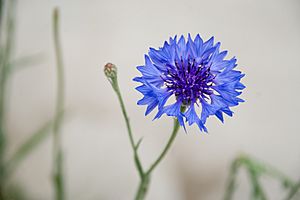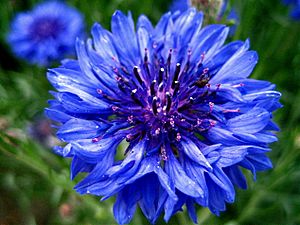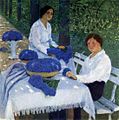Cornflower facts for kids
Quick facts for kids Centaurea cyanus |
|
|---|---|
 |
|
| Scientific classification | |
| Kingdom: | |
| Division: | |
| Class: | |
| Order: | |
| Family: | |
| Genus: |
Centaurea
|
| Binomial name | |
| Centaurea cyanus |
|
The cornflower, also known as bachelor's button, is a beautiful flowering plant. It grows every year and belongs to the Asteraceae family, which includes daisies and sunflowers. This plant originally comes from Europe.
Long ago, cornflowers often grew as a weed in fields where grains like wheat, barley, or oats were planted. This is how it got its name! Today, cornflowers are becoming rare in their natural homes. This is mainly because of modern farming methods, especially the use of chemicals called herbicides that destroy their habitat.
However, cornflowers are now found in many other parts of the world. People have planted them in gardens as ornamental plants. Their seeds also sometimes mix with crop seeds, helping them spread. You can now find them growing naturally in places like North America and Australia.
Contents
What Does a Cornflower Look Like?
A cornflower is an annual plant, meaning it lives for one growing season. It can grow to be about 16 to 35 inches tall. Its stems are branched and have a grey-green color. The leaves are small, usually 1 to 4 cm long.
The flowers are most often a bright blue color. They grow in flowerheads that are about 1.5 to 3 cm wide. Each flowerhead has a ring of larger, spreading petals around a center of smaller, disc-shaped flowers. The blue color comes from a special pigment called protocyanin. Cornflowers bloom all summer long.
Where Do Cornflowers Grow?
Cornflowers are native to temperate Europe. But they have spread and now grow naturally in many places outside of Europe. For example, they have been in the British Isles since the Iron Age.
In the United Kingdom, cornflowers have become very rare. They used to be found in 264 different places but are now only in 3 spots. Because of this, a group called Plantlife is working hard to bring them 'Back from the Brink'.
In Ireland, cornflowers are very rare in County Clare. They were common in the north-east of Ireland before the 1930s.
Other Names for the Cornflower
The cornflower has many other common names! Some of these include bachelor's button, bluebottle, boutonniere flower, hurtsickle, or cyani flower.
Sometimes, it's also called basketflower. However, this name can also refer to a different group of plants. To make sure people know which plant you mean, Centaurea cyanus is sometimes called the common cornflower.
Growing Cornflowers in Your Garden
People often grow cornflowers in their gardens because they are so pretty. There are many different types, called cultivars, that have been grown. These come in various soft colors, like pink and purple, not just blue!
Cornflowers are also grown in Canada for florists to use in flower arrangements. The most popular type for this is a double blue variety, such as 'Blue Boy' or 'Blue Diadem'. White, pink, lavender, and even very dark maroon colors are also grown, but less often.
If you want to grow cornflowers, here's what they need:
- Sunlight: They need lots of sun.
- Water: They need a good amount of water every day.
- Soil: The soil should be neutral (pH 6.6-7.5) to slightly alkaline (pH 7.6-7.8).
How Are Cornflowers Used?
Cornflowers are sometimes seen as a helpful weed. Their petals are edible, meaning you can eat them! They are often used to decorate food, like adding a splash of color to salads.
In herbalism, which uses plants for health, a special liquid made from cornflowers can help with conjunctivitis (pink eye). It can also be used as a wash for tired eyes.
Historically, cornflowers were valued for their beautiful blue color. They are also a common ingredient in some tea blends and herbal teas. For example, they are famous in the Lady Grey tea blend by Twinings.
Cornflower Stories and Meanings
In old stories, young men in love would wear cornflowers. If the flower faded quickly, it was a sign that the man's love was not returned.
The blue cornflower is the national flower of Estonia since 1968. For Estonians, it represents daily bread. It is also a symbol for several political parties in Estonia, Finland, and Sweden. It has been a symbol for social liberalism in Sweden since the early 1900s. It is also the official flower of the Swedish province of Östergötland.
The cornflower is also the school flower for Winchester College and Dulwich College in England. It is said that the founder of Dulwich College, Edward Alleyn, loved this flower.
The blue cornflower was once a national symbol of Germany. One story tells that Queen Louise of Prussia was running from Napoleon's army. She hid her children in a field of cornflowers. To keep them quiet, she wove wreaths for them from the flowers. Because of this, the flower became linked to Prussia. It was also the same color as the Prussian military uniform. After Germany became one country in 1871, the cornflower became a symbol for all of Germany.
Because of its link to Germany, the cornflower is the official symbol of the yearly German-American Steuben Parade.
In France, the Bleuet de France (French cornflower) is a symbol for the 11th November 1918 armistice. It is a common symbol for veterans, especially those from World War I. This is similar to the Remembrance poppies worn in the United Kingdom and Canada.
The cornflower is also a symbol for motor neurone disease and amyotrophic lateral sclerosis.
A cornflower design, called "Blue Cornflower," was used by Corning Glass Works for their Corning Ware Pyroceram Cookware. It became very popular in the United States, Canada, the United Kingdom, and Australia. It was so popular that it became the symbol of Corning Glass Works.
Images for kids
-
A honey bee on a cornflower
-
Isaac Levitan, Cornflowers, 1894.
-
Vincent van Gogh, Wheat Field with Cornflowers, 1890.
See also
 In Spanish: Aciano para niños
In Spanish: Aciano para niños












